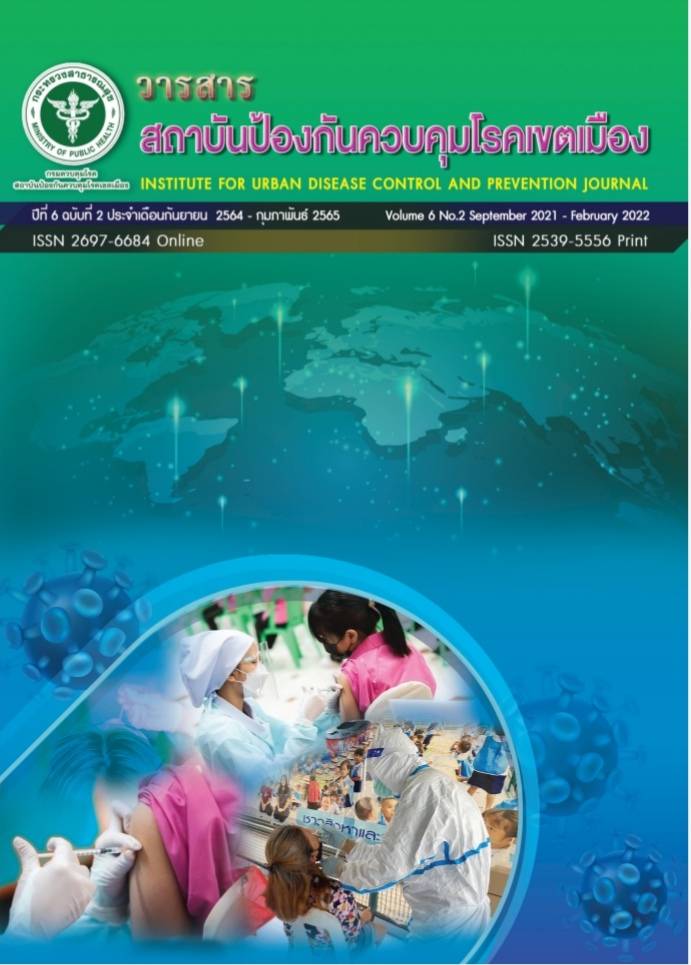การศึกษาความไว ความจำเพาะ และความถูกต้องของการใช้ชุดตรวจ Antigen Test Kits เปรียบเทียบกับการตรวจหาสารพันธุกรรมของเชื้อไวรัสโคโรนา 2019 แบบ Real time RT-PCR ณ. จุดให้บริการตรวจคัดกรองเชื้อไวรัสโคโรนา 2019 ภาคสนาม
Main Article Content
บทคัดย่อ
โรคติดเชื้อไวรัสโคโรนา 2019 หรือ โควิด 19 (COVID-19) ยังคงแพร่ระบาดอย่างต่อเนื่องทั้งในชุมชนและสถานประกอบการหลายแห่ง การควบคุมการระบาดของโรคที่สำคัญ คือ การตรวจเชิงรุก (Active case finding) ให้ได้มากที่สุด เพื่อแยกผู้ที่ติดเชื้อเข้ารับการรักษาพยาบาลอันเป็นการตัดวงจรการแพร่ระบาดของโรค กระทรวงสาธารณสุขจึงมีนโยบายใช้ชุดตรวจคัดกรองแบบรวดเร็ว เพื่อให้การเฝ้าระวัง สอบสวนและควบคุมโรคโควิด 19 ดำเนินได้อย่างมีประสิทธิภาพ
การศึกษาแบบพรรณนา เพื่อศึกษาถึงความสอดคล้องของผลการตรวจแบบ Antigen Test Kits (ATK) กับการตรวจหาสารพันธุกรรมของเชื้อไวรัสโคโรนา 2019 (SARS-CoV-2) ด้วยวิธี Real–time RT-PCR กลุ่มตัวอย่างได้รับการคัดเลือกแบบเฉพาะเจาะจง (Purposive sampling) คือ ผู้สงสัยติดเชื้อไวรัสโคโรนา 2019 ผู้สัมผัสใกล้ชิดจากสมาชิกในครอบครัวที่ติดเชื้อไวรัสโคโรนา 2019 หรือผู้สัมผัสใกล้ชิดผู้ป่วยยืนยันติดเชื้อไวรัสโคโรนา 2019 ที่เข้ารับการตรวจค้นหาโรคโควิด 19 เชิงรุกด้วยรถเก็บตัวอย่างชีวนิรภัย พระราชทาน ณ จุดตรวจราชมังคลากีฬาสถาน และสนามกีฬาธูปะเตมีย์ ระหว่างวันที่ 22–28 กรกฎาคม 2564 จำนวน 2,445 ราย
กลุ่มตัวอย่างที่มีผลตรวจทั้งแบบ ATK และ Real time RT-PCR พบผลลบลวง 82 ราย (11.15%) ผลบวกลวง 23 ราย (1.34%) ระยะเวลาตั้งแต่เริ่มเกิดอาการจนถึงการทดสอบในห้องปฏิบัติการในผู้สงสัยติดเชื้อไวรัสโคโรนา 2019 อยู่ระหว่าง 0–14 วัน โดยมีค่ามัธยฐาน 5 วัน ผลการทดสอบ Antigen Test Kits (ATK) พบ ความไว 95.36% (95%CI, 91.06–96.96%) ความจำเพาะ 96.60% (95%CI, 93.26–97.56%) ความถูกต้อง 96.46% (95%CI, 93.89–99.42%) ค่าทำนายเมื่อผลเป็นบวก 98% และ ค่าทำนายเมื่อผลเป็นลบ 88% ที่ความชุก 10% ของโรคโควิด 19
การศึกษานี้เชื่อว่าชุดตรวจ Antigen Test Kits (ATK) มีศักยภาพในการใช้งานที่รวดเร็ว เหมาะสมกับพื้นที่ที่มีความชุกของโรคสูง สำหรับผลลัพธ์เป็นลบอาจมีความจำเป็นต้องตรวจยืนยันเพิ่มเติมด้วย Real time RT-PCR ในกลุ่มเสี่ยงสูง เพื่อสามารถนำผู้ติดเชื้อหรือผู้มีเหตุสงสัยติดเชื้อ นำเข้าสู่กระบวนการแยกกัก รักษาได้อย่างรวดเร็ว ลดการป่วยหนักและเสียชีวิต
Article Details

อนุญาตภายใต้เงื่อนไข Creative Commons Attribution-NonCommercial-NoDerivatives 4.0 International License.
บทความที่พิมพ์ในวารสารสถาบันป้องกันควบคุมโรคเขตเมือง ถือว่าเป็นผลงานวิชาการ งานวิจัยและวิเคราะห์ ตลอดจนเป็นความเห็นส่วนตัวของผู้เขียนเอง ไม่ใช่ความเห็นของสถาบันป้องกันควบคุมโรคเขตเมือง หรือคณะบรรณาธิการแต่ประการใด ผู้เขียนจำต้องรับผิดชอบต่อบทความของตน
เอกสารอ้างอิง
2. อมรินทร์ นาควิเชียร, วิภาดา เหล่าสุขสถิต, วิทยา จอมอุย, ระรินทิพย์ บุญประดิษฐ์. การศึกษาความไว ความจำเพาะ และความถูกต้อง ของการใช้ชุดตรวจคัดกรองแอนติบอดีของโรคติดเชื้อไวรัสโควิด 19 เปรียบเทียบกับการตรวจโดยวิธีขยายสารพันธุกรรม (Real-time PCR) ในการวินิจฉัยภาวะติดเชื้อในผู้ป่วยที่ทำหัตถการทางสูติศาสตร์-นรีเวชวิทยาฉุกเฉินและบุคลากรทางการแพทย์. สถาบันวิจัยระบบสาธารณสุข; 2564.
3. กรมควบคุมโรค กระทรวงสาธารณสุข. ขอส่งแนวทางปฏิบัติการตรวจคัดกรองด้วย Antigen Test Kit (ATK) และการตรวจหาเชื้อโควิด-19. [เข้าถึงเมื่อ 29 สิงหาคม 2564]. เข้าถึงได้จาก: https://https://ddc.moph.go.th/ viralpneumonia/file/g_health_care/ antigen_test_kit_130764.pdf
4. Chutikan C, Bualan K, Nattaya T, Niracha A, Rujipas S, Methee C, et al. Rapid SARS-CoV-2 antigen detection assay in comparison with real-time RT-PCR assay for laboratory diagnosis of COVID-19 in Thailand. Virology journal 2020; 17(177): 1-7.
5. ธีรวุฒิ เอกะกุล. ระเบียบวิธีวิจัยทางพฤติกรรมศาสตร์และสังคมศาสตร์. อุบลราชธานี: สถาบันราชภัฏอุบลราชธานี; 2543.
6. บริษัท ไบโอเซนเซอร์.คู่มือการใช้งานอย่างง่าย ชุดตรวจโควิด 19 แอนติเจน. [แผ่นพับ]; 2563.
7. กรมวิทยาศาสตร์การแพทย์ กระทรวงสาธารณสุข. การตรวจวินิจฉัยโรคติดเชื้อไวรัสโคโรนา 2019.กรุงเทพมหานคร: กรมวิทยาศาสตร์การแพทย์; 2562.
8. Finlay C, Brett A, Henry L, Yuka J, Franck K, Neale B, et al. Increased transmissibility and global spread of SARS-CoV-2 variants of concern as at June 2020. Euro surveillance journal 2021;26(24): 1-6.
9. Alexander K, Christian G, Michael D, Mathias W, Matthias I, Michael K. Comparison of the SARS-CoV-2 Rapid antigen test to the real star Sars-CoV-2 RT PCR kit. Journal of Virological Methods 2021;288: 1-2.


